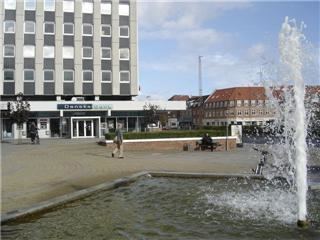Country Kingdom of Denmark District Viby Local time Sunday 10:03 PM | Postal code 8260 | |
 | ||
Weather 8°C, Wind W at 18 km/h, 88% Humidity | ||
Kongsg rdsvej 22 st 1 8260 viby j delevenlig 3 v r lejlighed p 111 kvm
Viby J (or just Viby) is a former town and now a district, in the southwestern part of Aarhus in Denmark. The district has almost 30,000 inhabitants. The "J" stands for Jutland, as there is another town called Viby on the island of Zealand, officially referred to as Viby Sj.
Contents
- Kongsg rdsvej 22 st 1 8260 viby j delevenlig 3 v r lejlighed p 111 kvm
- Map of 8260 Viby Denmark
- Etymology and origin
- Description
- Sports
- History
- References
Map of 8260 Viby, Denmark
Etymology and origin
Viby derives from the Old Norse words vi and by, meaning holy place and town respectively.
Vi is a word represented in many place names in both Denmark and Sweden. Several places are named Viby in both Denmark and Sweden (see Viby (disambiguation) for examples) and vi is also present in names like Viborg or the Swedish towns of Odensvi, Torsvi, Frösvi, Ullavi or Visby. Vi refers to "an enclosed holy place" and it is believed, that Viby was once a holy place where the Norse Gods were worshipped, with one or several cult houses. The shrines were probably located at what was formerly known as Tyrseng - the area around the large association football fields in the southwest of Viby. Tyrseng translates as Tyrs-meadow referring to the Norse God Tyr. These theories are backed up by other more or less sound evidence. In 1915 remains of an old hall dating from the Viking Age, was unearthed at the hill of Kongsbakke (lit.: kings-hill), when the public school of Viby Skole was constructed. Medieval sources explains, that the hill of Kongsbakke was once the site of a royal estate in ancient times. Our general research-based knowledge of the Norse culture in the Iron Age and Viking Age tells us, that kings and magnates settled near vis and hofs, as they also worked as priests of the Norse religion and were needed there to attend the rituals. Archaeological excavations conducted by Moesgård Museum at a motorway junction in Viby, has also revealed a former holy spring, a chapel and a cemetery used from the 11th century to around 1200.
Description
Apart from the former suburban town of Viby J, the postal district also includes the neighbourhoods of Kongsvang and Stavtrup
Viby J is primarily a working-class neighbourhood, including many immigrants, but the area also presents large boroughs of detached family houses for the upper-middle class. There are several educational institutions here, such as Viby Gymnasium and Aarhus Business College, making it a centre of education for its part of the city. Two major public housing projects are located in Viby J. Rosenhøj is made up by low-rise apartment blocks, while Grøfthøjparken comprise row house quarters, low-rise apartment blocks 4–6 stories tall and the landmark high-rise block of Grøfthøjhuset, with 17 floors and 51 meters tall. It is also the 6th tallest building in greater Aarhus.
The urban square of Viby Torv, is one of Aarhus' southernmost traffic nodes, joining the international E45 motorway with the Ring 2 ring road. There is a shopping centre at the square by the name of Viby Centret, including parking lots, a high-rise hotel and several office buildings and businesses.
Viby J houses the main editorial office of Jyllands-Posten.
Sports
Viby is known for its taekwondo-club, which has fostered several European Champions.
History
In the time of the Viking Age and early Middle Ages there was a castle in Viby.
In early July 1961, Århus Stiftstidende could announce that:
The expansions were intended to increase the population from the (at that time) current 16,000 to 50,000.
In 1970, the new shopping centre was taken into use. It had ended up costing about £4 million, instead of the originally estimated £1.85 million.
